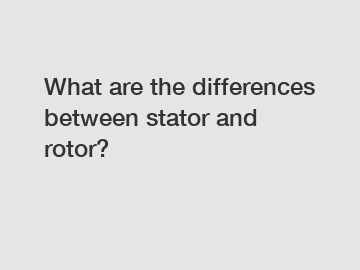What are the differences between stator and rotor?
In the world of machines and electrical devices, there are numerous components that work together harmoniously to achieve remarkable results. Two such crucial components are the stator and rotor, which are commonly found in various types of motors and generators. While both the stator and the rotor play pivotal roles in facilitating the movement and transfer of energy, they possess distinctive characteristics that set them apart. In this captivating blog, we delve into the key differences between the stator and rotor to shed light on their unique functionalities.
1. Anatomy and Structure:
The stator and rotor have distinct physical structures that contribute to their respective functionalities. The stator is a stationary component composed of a cylindrical metal core wrapped with insulated copper coils. It typically surrounds the rotor while maintaining a small air gap between them. On the other hand, the rotor is the moving part of the motor or generator and consists of a solid core, usually in the form of a cylinder or disc, which is also wound with copper coils.

2. Functionality:
Both the stator and rotor have crucial roles in the operation of electrical machines. The stator acts as the primary source of electromagnetic field formation, creating a stable magnetic field that interacts with the rotor. This interaction is crucial for the generation of torque or electromotive force, depending on the specific type of machine. Conversely, the rotor, being the moving component, facilitates the conversion of electrical energy into mechanical energy or vice versa. Its rotation creates the necessary motion to propel the machine and transfer the energy effectively.
3. Power Supply:
Another important distinction lies in the power supply to the stator and rotor. The stator receives electrical energy directly from an external source, which may be either AC (Alternating Current) or DC (Direct Current). This external supply creates the primary magnetic field within the motor or generator. In contrast, the rotor is powered by electromagnetic induction, utilizing the magnetic field generated by the stator to induce a secondary current within its coils. This induced current then leads to the creation of a magnetic field in the rotor, enabling its rotation.
4. Motion:
One prominent difference between the stator and rotor lies in their motion. As mentioned earlier, the stator remains stationary, serving as the anchor that provides the necessary magnetic field. Its unwavering position allows for a consistent and predictable magnetic flux distribution, ensuring a stable operation. In contrast, the rotor is designed to rotate in response to the electromagnetic forces generated by the stator. This rotational movement is essential for driving various applications such as industrial machinery or powering electrical generators.
5. Magnetic Configuration:
Understanding the magnetic configuration within the stator and rotor is crucial to discerning their differences. In the stator, the formation of a magnetic field is achieved through the arrangement of the copper windings in specific configurations, such as concentric coils or distributed winding. This configuration ensures a uniform distribution of the magnetic flux, resulting in a steady and efficient energy transfer. Conversely, the rotor's magnetic configuration is characterized by permanent magnets or interconnected winding arrangements like squirrel-cage or wound-rotor, providing the required flux linkage for effective operation.
Conclusion:
In conclusion, the stator and rotor are integral components in motors and generators, working in harmony to facilitate energy transfer and mechanical motion. While the stator remains stationary and generates the primary magnetic field using externally supplied electrical energy, the rotor is the moving part that utilizes electromagnetic induction to convert electrical energy into mechanical energy or vice versa. Understanding the unique characteristics, functions, and configurations of both these components allows us to appreciate their remarkable cooperation and contribution in numerous applications.
As we have unveiled the mysteries surrounding the differences between the stator and rotor, let us appreciate the intricate designs and engineering marvels that make our machines work efficiently.
For more stator and rotor core, stator lamination welding, Sub-assembly productioninformation, please contact us. We will provide professional answers.


